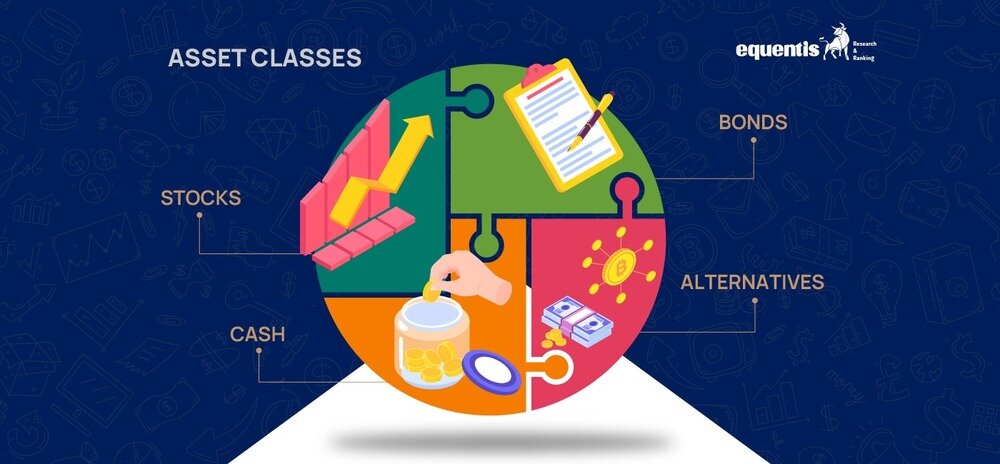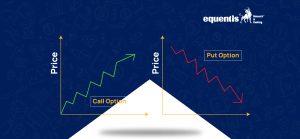The stock market is full of investment options associated with benefits and risks. However, your success and growth potential depend on the investment portfolio that you build.
To stay profitable in the market and minimize risks, you must have a diversified portfolio that includes investments from different asset classes, such as stocks, bonds, and mutual funds.
But what exactly are these asset categories, and what should be your investment strategy for each? That’s what we will discuss in this blog.
What Is an Asset Class?
Asset classes refer to the collection of investment instruments with similar characteristics and market behavior. For instance, stocks and bonds are two common asset classes. Stocks represent ownership in a company, while bonds are debt securities issued by governments or corporations. These classes are categorized based on the nature of assets, financial goals, and stock market fluctuations.
Other asset classes also exist in addition to the ones mentioned above. These include cryptocurrencies, hedge funds, etc.
These are known as alternative asset classes because they do not fall under the purview of the traditional asset classes. These are associated with higher risk, complex structure, and higher liquidity.
Also Read: SEBI Registered Investment Advisor: Meaning & Eligibility
Types of Asset Classes: Classification of Different Asset Types
- Equity: Equity refers to the ownership of investors in a company. This asset class includes stocks and shares in a company that you can purchase and benefit from, such as dividends and capital appreciation.
- Fixed Income: Fixed income represents investments that offer a continuous flow of income in the form of dividends or interests. This asset class includes government bonds, corporate bonds, treasury securities, etc., offering investors a fixed return rate over a specified investment horizon.
- Commodities: Commodities refer to raw materials or other products traded on various commodity exchanges. These include physical goods like gold, silver, oil, agricultural products, and metals. You can either directly invest in commodities or use commodity futures contracts. Another important point to note about commodities is that they offer diversification benefits and prevent the negative impacts of inflation.
- Cash and Cash Equivalents are highly liquid and low-risk investment instruments capable of providing better stability but low returns. Liquidity refers to how quickly and easily an investment can be converted into cash without significant loss of value. Some examples of highly liquid investments include bank deposits and physical currency. This is an important asset class that brings liquidity and stability to your investment portfolio, as it allows you to access your money quickly if you need it.
- Derivatives: Derivatives refer to financial contracts between two parties whose value is based on the underlying assets. They include Options, Futures, Forwards, and Swaps. These are primarily used for speculation, risk management, and investment in the stock market.
- Real Estate: It includes purchasing real estate assets like houses, plots, buildings, etc., for commercial or residential purposes or simply as a means of future investment. This asset class is popular among investors who prefer low risk and safety against inflation.
Different Asset Classes and Investing Strategy
You can maximize your returns while reducing your risk exposure by investing across a balanced portfolio of stocks, bonds, real estate, etc.
However, as mentioned above, your success will depend on your investment strategies regardless of your chosen asset class.
So, how do we devise robust investment strategies for different classes of assets? By taking into account the following factors:
- Risk profile: Each asset class comes with a different level of risk. So, before investing, take your time to understand the risk associated with your selected asset class and ensure that it aligns with your risk appetite.
- Return Potential: Another factor to consider before investing in different asset classes is their risk potential. Invest in instruments that can provide you with desired returns while maintaining a low-risk exposure.
- Investment Horizon: The investment horizon is the timeframe you want to stay invested in the stock market. If you are a short-term investor, short-term bonds, cash and cash equivalents, etc., are efficient choices. On the other hand, investing in mutual funds and stocks is a better option if you have long-term plans.
- Investment Budget: Finally, decide on your investment budget. This might sound insufficient, but it is critical to invest in the stock market successfully. This approach will help you maximize your investment without risking your financial situation.
Strategic planning and conducting in-depth market research are crucial steps in your investment journey. By taking these proactive measures, you can feel confident and in control of your investment decisions, knowing that you have thoroughly considered all the relevant factors.
Thankfully, many financial calculators can help you estimate your growth potential with a particular investment instrument.
For instance, you can use a retirement planning calculator to determine how much wealth you need to generate during your working career to live a stress-free life after retirement.
What are the Most Popular Asset Classes?
Equities, bonds, and cash equivalents are by far the most popular asset classes among investors worldwide. Among these, stock investments have proven to be the most profitable asset classes with respect to historical returns.
Stock market investments hold the potential to generate significantly higher returns over the long term than other asset classes. This exciting prospect allows you to adjust your risk-return ratio based on your preferences, offering a world of possibilities for your investment strategy.
For instance, if you have a low-risk tolerance, you can invest in large-cap stocks. Similarly, if you want to generate higher returns and are willing to take a higher calculated risk, you can invest in small-cap stocks.
The Bottom Line
Asset classes play a vital role in diversifying investment portfolios, offering a shield against market volatility. By investing across different asset types, you can feel secure and protected, optimizing your returns while reducing your risk exposure.
As we mentioned in the blog, instead of investing in a single type of asset, consider investing in a balanced portfolio containing different classes of assets. Working with a SEBI-registered investment advisory can be highly beneficial. These professionals are regulated by the Securities and Exchange Board of India (SEBI) and can provide expert advice on investment strategies, asset allocation, and risk management. This can be particularly helpful if you are a beginner or have less investment experience.
How useful was this post?
Click on a star to rate it!
Average rating 0 / 5. Vote count: 0
No votes so far! Be the first to rate this post.
I’m Archana R. Chettiar, an experienced content creator with
an affinity for writing on personal finance and other financial content. I
love to write on equity investing, retirement, managing money, and more.
- Archana Chettiar













